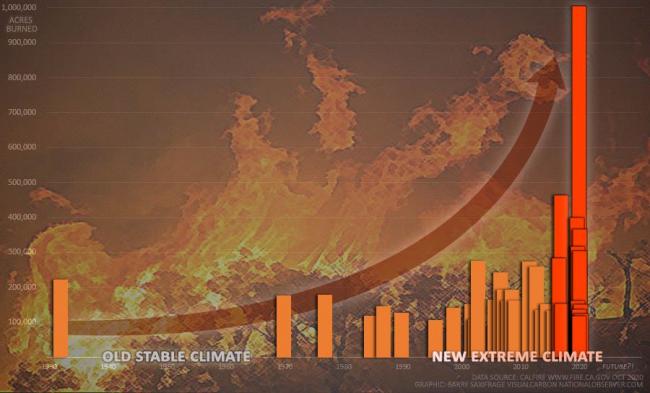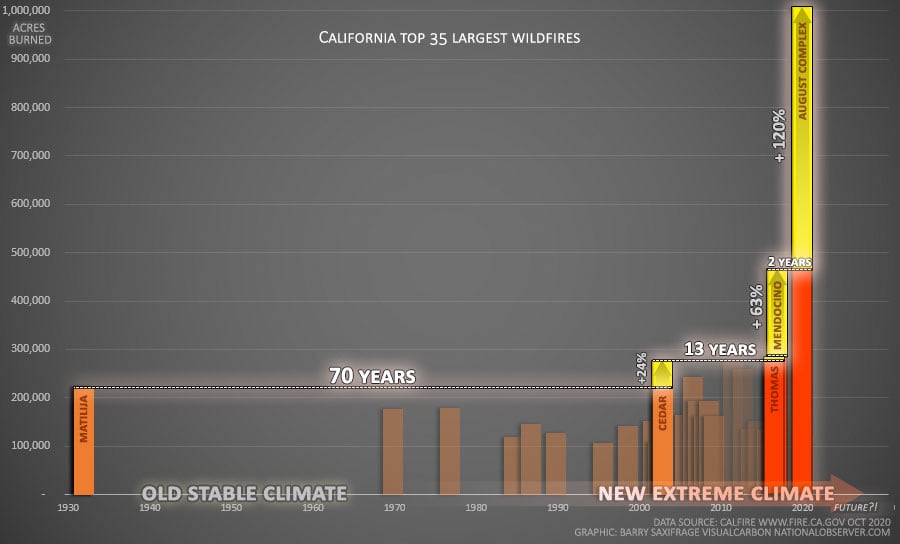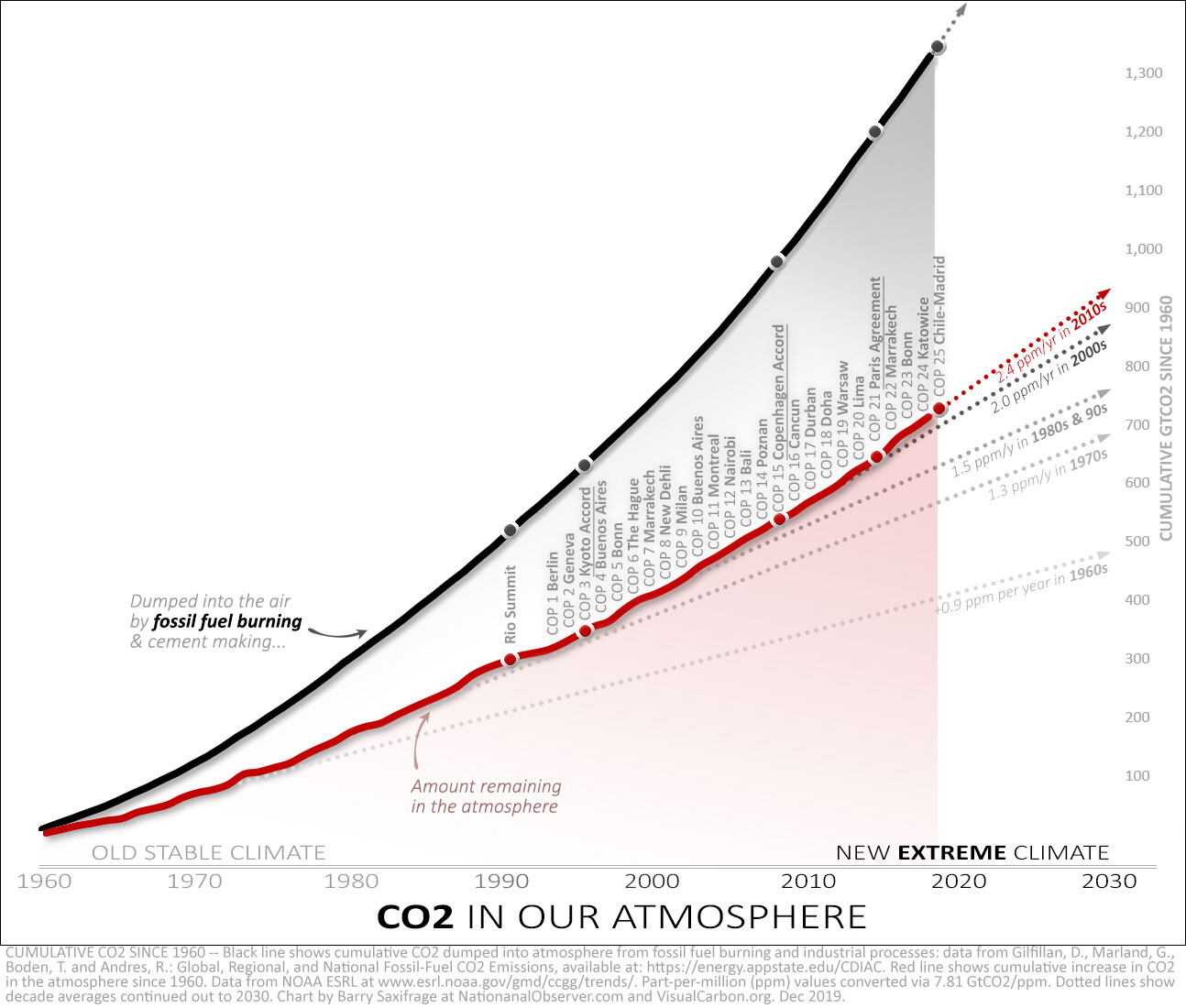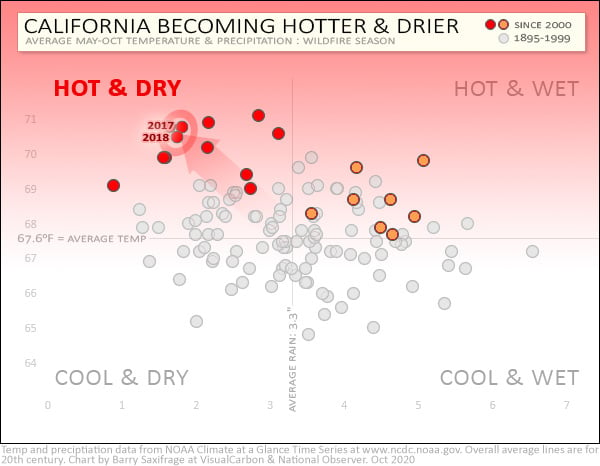Articles Menu

October 20th 2020
California is on the burning edge of climate breakdown. Record temperatures are teaming up with record droughts to turn the Golden State into a tinderbox. The megafires have followed, erupting with stunning speed and ferocity across forests, grasslands, rural areas and city neighbourhoods.
These megafires, each burning more than 100,000 acres, are rising exponentially — both in frequency and size.
And all this is unfolding with just one degree of global heating, so far. Unfortunately for all of us, the primary fuel for global warming — the CO2 humans are adding to our atmosphere — is also rising exponentially. We've already burned down our old, calmer and more stable climate. It's gone. Sorry, kids.
And yet even now, instead of turning back towards safety, we continue to crank up the climate burner — cooking up an ever-more turbulent, hostile and extreme climate future.
To illustrate the scale, pace and climate connections of California's megafire crisis, I’ve dug into years of wildfire reports and the latest climate science to chart what's happening.
Let's start by looking at California’s 35 largest wildfires since accurate, modern records started being kept around 1930. My chart below arranges them by year, and the height of each bar shows the number of acres burned. Bars in red are fires from the last three years.

As you can see, megafires used to be rare in our old, lower-energy, stable climate. But in our new extreme climate, they are arriving with startling frequency. In fact, eight of the state's 35 largest wildfires on record — including five of the top six — burned this year.
Just as troubling, the size of the largest fires is also rising exponentially. My next chart highlights this rise in yellow.

Back in the early 1930s, the Matilija Fire ripped through the forests around Santa Barbara, burning nearly 220,000 acres. It was the largest known fire in the state's history. There may have been one fire in the previous century that was larger, but it burned before accurate measurements were made.
"Record temperatures are teaming up with record droughts to turn the Golden State into a tinderbox," writes @bsaxifrage. "The megafires have followed, erupting with stunning speed and ferocity."
After the Matilija Fire, Californians enjoyed a 70-year stretch without another inferno of that scale. That's what living in the old, stable, lower-energy climate was like — record-breaking extremes were blessedly rare. Don't you wish you and your loved ones were still living with that climate? I sure do.
In 2003, Matilija's record finally fell when the Cedar Fire near San Diego torched 273,000 acres. It burned an area 24 per cent larger. Sadly, this new megafire record would last for only 13 years.
In 2017, the Thomas Fire rampaged through suburbs just north of Los Angeles, burning a record 282,000 acres. This fire was a climate wake-up call for many. For one thing, it broke the record despite an armada of firefighters, bulldozers, tankers and water bombers thrown at it to try to keep it out of neighborhoods and city centres. Even more troubling, all this happened during December, making it California's first “rainy season” fire to even break into the top 20.
Only a year later, the sprawling Mendocino Complex fire jumped off the charts, burning nearly 460,000 acres. This was an eye-popping 63 per cent leap in size from the old record set just the year before.
And two years after that, the still burning August Complex fire exploded to more than twice that size. As I write, it's already burned over a million acres and is only two-thirds contained. The current estimated containment date is still a month away.
“The climate system is an angry beast and we are poking it with sticks.” — often-repeated warning by the late climate scientist Wallace S. Broecker
Climate science has long warned that dumping ever more fossil fuel pollution into our atmosphere will lead to ever-more extreme fire conditions.
Here's a chart showing cumulative global fossil fuel CO2 emissions since 1960; that's the black line. The red line below it is the amount that has remained in the atmosphere driving global heating. As you can see, both are continuing to rise exponentially. We are literally accelerating away from climate safety and towards an increasingly energized and dangerous climate system.

Climate science has documented many ways in which our human-caused global heating is turbocharging wildfires. These include more extreme winds driving the flames faster, hotter nights that keep fires raging when they used to damp down and the unleashing of hordes of tree-killing insects that have killed a "staggering" 129 million trees in California alone in just the last few years, creating super-fuelled fire cores that are hard to put out. But the most powerful climate hammer of all is the rapid rise in the number of days that are both hotter and drier.
A new study led by researchers from McGill University is the latest in the long line of science reports linking climate change to rising wildfires. It focuses on this convergence of heat waves and droughts — what they call the "disastrous duo." Their research shows these hot-dry events are becoming increasingly common and more extreme in western parts of the United States due to climate change. And their study explains how these dual “hot-dry extremes” are the conditions that breed explosive, hard-to-contain megafires.
To illustrate this rising hot-dry trend, I've charted NOAA data for the average temperature and precipitation in every California wildfire season since 1895. (h/t to @RARohde)

Grey dots show the years from 1895 to 1999. Red and orange dots show 2000 to 2019.
Notice how every year since 2000 has been hotter than the “old normal,” with several in record hot territory. And notice how most of these years were also drier than the “old normal” (red dots).
I've further labelled the extreme megafire years of 2017 and 2018 to highlight just how extreme the “disastrous duo” of hot-dry conditions were then.
This year, 2020, doesn’t yet appear on this chart because October isn't over. But it has already entered the record books as the hottest California summer on record. And, so far, it has been one of the driest as well.
The McGill researchers also found another troubling fact. The trigger for these extreme hot-dry events has shifted dangerously. In our old, lower-energy climate, these events were driven primarily by the lack of rain. But now rising temperatures have reached the point where our new extreme heat waves are enough by themselves to cook the landscape into extreme dryness, even when the rains don't fail. And the most certain prediction of future climate change is that temperatures will continue rising until humans stop emitting fossil fuel pollution — and likely for a while longer after that.
There will always be sparks to start fires in California, from both nature (lighting) and humans. But to turn a common small brush fire into a city-eating megafire requires a lot of kindling-dry fuel (forests, brush, grassland) that burns explosively fast. That's what extreme hot-dry conditions deliver.
As one example, the off-the-charts Mendocino Complex fire in 2018 was started when a rancher was driving a metal stake into the ground. A spark jumped off and ignited the bone-dry landscape faster and more furiously than even modern firefighting technology and crews could contain. Driving metal stakes into the ground isn't new. Extreme hot-dry fire conditions are.
These extreme hot-dry weather conditions are expected to keep rising exponentially. As Park Williams, a climate scientist at Columbia University and an author of another recent California wildfire study, told the Atlantic: “Each degree of warming causes way more fire than the previous degree of warming did. And that’s a really big deal.”
I remember vividly a winter day, back in 2009, when the U.S. Secretary of Energy Steven Chu, a Nobel Prize-winning physicist, voiced his deep concerns for what climate change could do his home state. “I don't think the American public has gripped in its gut what could happen ... We're looking at a scenario where there's no more agriculture in California.” And, he added: “I don't actually see how they can keep their cities going.”
A decade later, in 2018, as yet another extreme fire year was shattering the records for both biggest fire and total area burned in a single year, then-Gov. Jerry Brown held a press conference: “This is not the new normal. This is the new abnormal ... Unfortunately, the best science is telling us that dryness, warmth, drought, all those things, they’re going to intensify ... We have a real challenge here threatening our whole way of life.”
Right on cue, the fires of 2020 have obliterated both those records — more than doubling the worst that came before. That's what exponential change feels like. What seems impossibly distant a few years ago suddenly arrives with bewildering speed.
As climate scientist Philip B. Duffy told the New York Times last month: “People are always asking, ‘Is this the new normal?’ I always say no. It’s going to get worse.”
How much worse will depend upon how soon we all decide to stop emitting climate pollution.
It is a good time to review what we here in Canada are doing with our climate pollution. Canada remains one of the world's “dirty dozen” countries, both in terms of total climate pollution emitted and in emissions per capita. Despite pledging new climate targets nine separate times over the last 30 years, we've yet to come close to living up to any of them.
Cutting climate pollution and living up to climate promises is certainly possible. Our economic and Commonwealth peer, the United Kingdom, has reduced its emissions 42 per cent since 1990. We've increased ours by 21 per cent. The U.K. long ago enacted an effective Carbon Budget law that legally binds their governments to meet targets that include all emissions in every year. Our federal government, in contrast, has no such laws and has yet to even create a plan that would meet any of our climate targets. Not even close. So it is both deeply discouraging, and yet unsurprising, that our climate pollution emissions in Canada are still headed in the wrong direction, rising, not falling, in recent years.
As we continue our foot-dragging in Canada, the climate beast is waking up. When will we?
[Top chart: California's top 35 largest wildfires. Chart and graphic by Barry Saxifrage.]